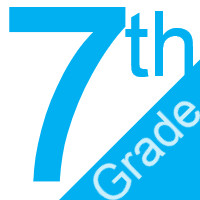ELA-07.SL.01
|
7th Grade ELA Targeted Standards
(SL) Speaking and Listening Strand
Cluster: Comprehension and Collaboration
ELA-07.SL.01 Engage effectively in a range of collaborative discussions (one-on-one, in groups, and teacher-led) with diverse partners on grade 7 topics, texts, and issues, building on others’ ideas and expressing their own clearly.
- a. Come to discussions prepared, having read or researched material under study; explicitly draw on that preparation by referring to evidence on the topic, text, or issue to probe and reflect on ideas under discussion.
- b. Follow rules for collegial discussions, track progress toward specific goals and deadlines, and define individual roles as needed.
- c. Pose questions that elicit elaboration and respond to others’ questions and comments with relevant observations and ideas that bring the discussion back on topic as needed.
- d. Acknowledge new information expressed by others and, when warranted, modify their own views.
|
Student Learning Targets for Grade 7 Communications:
Knowledge Targets
- I can identify the roles and rules necessary for collaborative discussions.
Reasoning Targets
- I can review materials and determine key points and/or central ideas.
Skills (Performance) Targets
- I can create questions and locate key textual evidence to contribute to a discussion on the given topic, text, or issue.
Product Targets
- I can track the progress of a discussion and recognize when the discussion is getting off-topic.
Student Learning Targets for Grade 7 Reading Pro:
Skills (Performance) Targets
- I can engage in a group discussion with classmates.
- I can engage in a teacher-led group discussion with diverse partners on grade 7 topics.
- I can engage in a discussion on grade 7 topics, texts, and issues building on others' ideas and expressing their own clearly.
Proficiency Scale for Grade 7 Communications:
| Score |
|
7.SL.01 Engage effectively in a range of collaborative discussions (one-on-one, in groups, and teacher-led) with diverse partners on grade 6 topics, texts, and issues, building on others’ ideas and expressing their own clearly. |
Sample Activity
|
| 4.0 |
In addition to Score 3.0, the student demonstrates advanced discussion abilities by
- bringing additional evidence outside of the prepared material and by explicitly drawing on that evidence to probe and reflect on the ideas or issues under discussion.
- leading discussion.
- posing and responding to specific questions that relate to and extend beyond the initial topic.
- identifying key ideas and describing how those perspectives pertain to them personally as well as to the world around them (reflection and paraphrasing).
- facilitating the organization and implementation of collaborative discussions.
|
|
| |
3.5 |
In addition to Score 3.0 performance, the student demonstrates in-depth inferences and applications regarding the more complex content with partial success. |
| 3.0 |
“The Standard.” The student demonstrates no major errors or omissions regarding any of the information and processes that were end of instruction expectations.
The students can
- Come to discussions prepared, having read or studied required material; explicitly draw on that preparation by referring to evidence on the topic, text, or issue to probe and reflect on ideas under discussion.
- Follow rules for collegial discussions, set specific goals and deadlines, and define individual roles as needed.
- Pose and respond to specific questions with elaboration and detail by making comments that contribute to the topic, text, or issue under discussion.
- Acknowledge new information expressed by others and, when warranted, express own views. (reflection or paraphrasing)
- make productive contributions to discussions.
- support claims through focused research.
- actively participate with others in a collaborative discussion.
|
- weekly checklist
- group’s weekly agenda
- debating ethical dilemmas
- weekly self-evaluation and reflection
|
| |
2.5 |
The student demonstrates no major errors or omissions regarding the simpler details and processes (Score 2.0 content) and partial knowledge of the more complex ideas and processes (Score 3.0 content). |
| 2.0 |
The student demonstrates no major errors or omissions regarding the simpler details and processes but exhibits major errors or omissions regarding the more complex ideas and processes (Score 3.0 content).
The students can
- come to discussion partially prepared having read/studied most of required material; attempt to draw on preparation by referring to evidence on the topic, text, or issue to probe and reflect on ideas under discussion.
- attempt to follow the rules for collegial discussions, set specific goals and deadlines, and define individual roles as needed.
- pose or respond to specific questions with elaboration and detail by making comments that contribute to the topic, text, or issue under discussion.
- attempt to acknowledge new information expressed by others and, when warranted, express own views.
- make minimal contributions/collaboration to discussions.
- find information with prompts.
|
- teacher provided organization sheets
- weekly self-evaluation and reflection
- weekly checklist
|
| |
1.5 |
The student demonstrates partial knowledge of the simpler details and processes (Score 2.0 content) but exhibits major errors or omissions regarding the more complex ideas and procedures (Score 3.0 content). |
| 1.0 |
With help, the student demonstrates a partial understanding of some of the simpler details and processes (Score 2.0 content) and some of the more complex ideas and processes (Score 3.0 content), but this student consistently
- does not come to discussion prepared.
- does not follow the rules for collegial discussions, set specific goals and deadlines, and define individual roles as needed.
- does not pose or respond to specific questions with elaboration and detail. Makes minimal comments that contribute to the topic, text, or issue under discussion.
- does not attempt to acknowledge new information expressed by others and, when warranted, express own views.
|
|
| |
0.5 |
With help, the student demonstrates a partial understanding of some of the simpler details and processes (Score 2.0 content) but not the more complex ideas and processes (Score 3.0 content). |
Communications 7: Speaking and Listening Rubric
| |
Exceeds (4) |
Proficient (3) |
Partially Proficient (2) |
Novice (1) |
| SL.01.b |
Leads the discussion.
|
Follows rules for collegial discussions, sets specific goals and deadlines, and defines individual roles as needed.
|
Attempts to follow the rules for collegial discussions, set specific goals and deadlines, and define individual roles as needed.
|
Does not follow the rules for collegial discussions, set specific goals and deadlines, and define individual roles as needed.
|
| SL.01.C |
Poses and responds to specific questions that relate and extend beyond the initial topic. |
Poses and responds to specific questions with elaboration and detail by making comments that contribute to the topic, text, or issue under discussion.
|
Poses or responds to specific questions with elaboration and detail by making comments that contribute to the topic, text, or issue under discussion. |
Does not pose or respond to specific questions with elaboration and detail. Makes minimal comments that contribute to the topic, text, or issue under discussion. |
| SL.01.d |
Identifies the key ideas and describe how those perspectives pertain to them personally as well as the world around them. (Uses both reflective feelings and paraphrasing) |
Acknowledges new information expressed by others and, when warranted, express own views. (uses reflective feelings or paraphrasing)
|
Attempts to acknowledge new information expressed by others and, when warranted, express own views. |
Does not attempt to acknowledge new information expressed by others and, when warranted, express own views. |
Proficiency Scale for Grade 7 Reading Pro:
| Score |
|
Description |
Sample Activity
|
| 4.0 |
In addition to Score 3.0, the student demonstrates in-depth inferences and applications regarding more complex material that go beyond end of instruction expectations. |
- |
| |
3.5 |
In addition to Score 3.0 performance, the student demonstrates in-depth inferences and applications regarding the more complex content with partial success. |
| 3.0 |
“The Standard.” The student demonstrates no major errors or omissions regarding any of the information and processes that were end of instruction expectations.
The student comes to discussions prepared, having read or studied required material:
-
Shows notes/annotation of text as evidence of preparation.
-
During discussion, uses textual evidence to support ideas.
-
Verbally gives input at all levels of discussion, in small group, large group, whole group.
-
Asks and answers questions of the text.
Within discussion, the student exhibits no major errors or omissions regarding an understanding of the text.
|
- |
| |
2.5 |
The student demonstrates no major errors or omissions regarding the simpler details and processes (Score 2.0 content) and partial knowledge of the more complex ideas and processes (Score 3.0 content). |
| 2.0 |
The student demonstrates no major errors or omissions regarding the simpler details and processes but exhibits major errors or omissions regarding the more complex ideas and processes (Score 3.0 content).
Within discussion, student reveals no major errors or omissions regarding the simpler details of the text as the student:
-
shows verbal evidence of reading, but has not prepared for discussion beyond reading
-
supports some ideas with textual evidence, but not consistently
-
provides input in some levels of discussion, but not with whole group
-
answers some questions posed from the group, but does not ask questions that help advance discussion.
However, the student exhibits major errors or omissions regarding the more complex ideas and concepts of text.
|
- |
| |
1.5 |
The student demonstrates partial knowledge of the simpler details and processes (Score 2.0 content) but exhibits major errors or omissions regarding the more complex ideas and procedures (Score 3.0 content). |
| 1.0 |
With help, the student demonstrates a partial understanding of some of the simpler details and processes (Score 2.0 content) and some of the more complex ideas and processes (Score 3.0 content). |
- |
| |
0.5 |
With help, the student demonstrates a partial understanding of some of the simpler details and processes (Score 2.0 content) but not the more complex ideas and processes (Score 3.0 content). |
Resources
Websites
- Add resources with links, youtube or PDF
Vocabulary
|
 Standards Glossaries
Standards Glossaries Standards Glossaries
Standards Glossaries Standards Glossaries
Standards Glossaries Standards Glossaries
Standards Glossaries Standards Glossaries
Standards Glossaries


 Strand (SL)
Strand (SL)